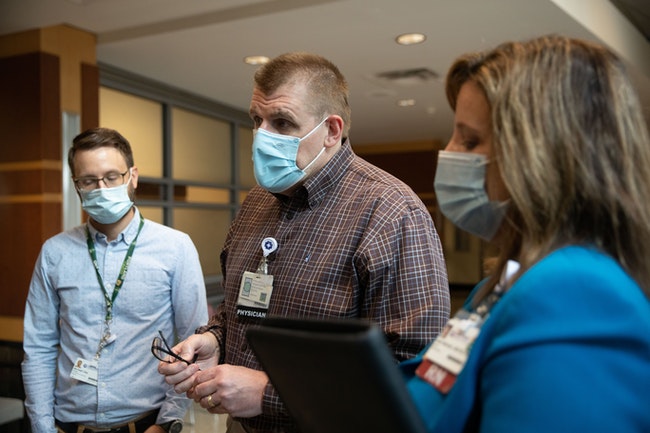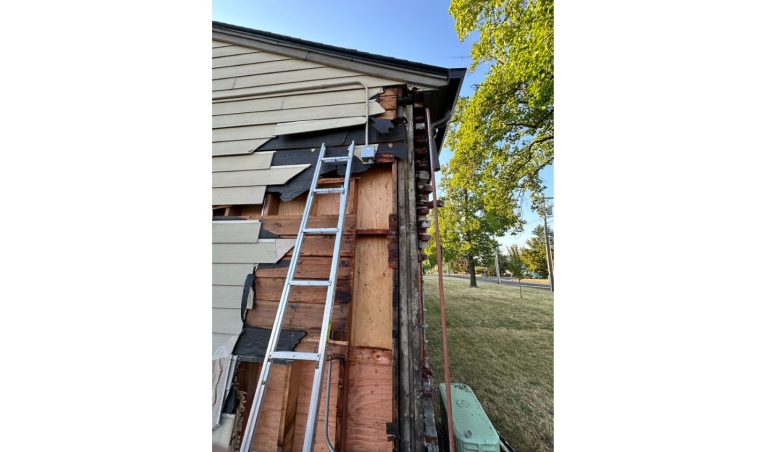As Delta surge wanes, Salem Hospital is busier than ever


Dr. Marty Johnson, pulmonologist and ICU medical director, speaks with reporters at Salem Health on Friday, Aug. 20, 2021. (Amanda Loman/Salem Reporter)
For the first time in weeks, Dr. Marty Johnson feels like he’s doing the work he was trained to do.
The pulmonologist, who serves as medical director of Salem Hospital’s intensive care unit, said as the Delta surge of Covid has waned in recent weeks, he’s seeing a more typical mix of patients in the 30-bed unit on the hospital’s fourth floor. That means patients who typically stay just a few days and are more likely to survive their illnesses.
“It’s somewhat of a relief,” he said.
But less Covid hasn’t translated to a less busy hospital. For the past week, the hospital has routinely had 500 or more patients, over its licensed capacity of 494. (Federal emergency waivers related to the pandemic allow Salem Hospital to care for additional patients.)
The hospital went over capacity several times during the Delta surge, but daily capacity updates provided to Salem Reporter show it’s now busier than ever. On Wednesday, it hit 542 patients – 110% capacity.
There’s no common demographic or type of illness providers are seeing. Hospital leaders said they can’t point to a single cause for the surge in patients.
“Your guess is as good as ours,” said Sarah Horn, the hospital’s chief nursing officer.
But Horn said the trend mirrors other lulls between pandemic waves. When Covid cases are high in the community, patients with other illnesses delay needed medical care. When cases fall, she said, the hospital tends to see an increase in people seeking care for other conditions.
“Oftentimes these particular patients are quite ill, and they’ve been holding on for some time,” she said. Prior to the pandemic, she said the hospital rarely hit 100% capacity. Last week, they recorded 512 inpatients.
“We’ve never ever in history had that many patients in our walls,” she said.
In the ICU, Johnson said some have pneumonia, which typically begins increasing in the fall as kids head back to school and other respiratory viruses circulate in the community. Some have failing hearts or kidneys caused by chronic illnesses.
Caring for them is intense, challenging, and can be life-or-death.
But Johnson said it’s also different from having a unit full of Covid patients who are on ventilators.
A more typical ICU patient stays three or four days, not the 12-day average for those severely ill with Covid. Many get better, a rewarding experience for hospital workers.
For those without Covid, Johnson said it’s often clear which patients aren’t likely to survive based on their illness and condition. Covid patients may spend weeks in intensive care without doctors knowing whether they’ll pull through.
“If there isn’t immediate improvement, a lot of times there’s a rapid segue to end-of-life care. You don’t have those kinds of discussions with young Covid patients. It’s much easier on your psyche as a provider to have that sort of plan and endpoint and have a course to go with those patients,” he said.
And, he said, care for other ICU patients isn’t politicized. Nurses don’t spend their time discussing vaccines with family members or fending off misinformation about Covid and its treatment.
As the number of Covid infections has fallen in the Salem area – and statewide – over the past few weeks, Salem Hospital has seen a steady decline in the number of Covid patients.
On Sept. 6, the hospital hit a peak of 112 Covid inpatients, nearly one quarter of all occupied beds. Twenty-two of them were in the hospital’s 30-bed ICU.
As of Tuesday, that number was down to 52, with 11 in the ICU.
Horn said delays in discharging patients to skilled nursing facilities remains a problem and is contributing to a higher patient count.
Daily, she said the hospital has between 30 and 50 patients who no longer need hospital-level care, but can’t be sent to a nursing facility because they’ve tested positive for Covid, or because staffing shortages mean there’s no bed available for them.
The problem isn’t new since the pandemic began, but it’s worsened. Pre-pandemic, Horn said they’d see at most 20 patients awaiting a nursing facility bed.
“That’s 10 to 30 more patients we have every day who don’t necessarily need to be here,” Horn said. “
Johnson and Horn said their staff are managing, and the hospital continues to rely on traveling nurses and respiratory technicians to cover shifts. Their work is less intense with fewer Covid patients to care for.
“I don’t mean to say we’re out of the woods and things are hunky-dory. It’s so burdensome for the nurses, obviously. There’s just less of it,” Johnson said.
If there’s been an upside to the chaos of the pandemic, it’s that health care workers have grown closer together.
“Many of the individuals that we take care of in this hospital are our family or our friends,” Horn said. “There’s an overall sense of pride.”
Now, their concern is the impact of the winter cold and flu season – typically the busiest time of year for hospitals.
Last winter, Oregon saw very little influenza, which doctors and public health workers attributed to masking, social distancing and school closures which kept people from mingling in many of the settings where flu viruses typically spread.
Johnson said he’s already seeing more ICU patients with other respiratory illnesses like pneumonia not caused by Covid.
“We had a relatively low flu vaccination rate as a community last year, so people are going to be a little more vulnerable this year,” he said.
Before the pandemic, he said children mingling in schools was a source of serious respiratory illness because kids would spread the virus to adults in the community who were more vulnerable. Though schools are now requiring masks and other Covid mitigation measures, he’s worried about flu season materializing as the hospital is still seeing dozens of Covid patients.
He urged people to get a flu shot and continue wearing masks, washing hands and taking other steps to avoid illness.
Horn said she doesn’t expect an end to the high volume of patients anytime soon.
“It feels like you’re running a long marathon and you might have made it over the hill but you still have 13 miles to go,” Horn said.
This article was updated to include the Oct. 27 hospital inpatient count.
Contact reporter Rachel Alexander: [email protected] or 503-575-1241.
JUST THE FACTS, FOR SALEM – We report on your community with care and depth, fairness and accuracy. Get local news that matters to you. Subscribe to Salem Reporter starting at $5 a month. Click I want to subscribe!



